@NeverDie Thank you for sharing the device you use. I am based in eu and 240 V ac and I think i will just pick one with lcd that can show the highest range even without sounding alarm. Just to check if it is of any concern to me.
My wife got candy canes, 7 sets 2xAA battery operated modules containing 40 leds each and i am trying to find a way to power them and wire them to one power source. Reading online it looks to be over complicated with so many things to calculate. This is just a side not not relevant to this post and the reason i didn't reply to your posts.
vecnar
Posts
-
Connecting smoke detectors to house alarm -
Connecting smoke detectors to house alarm@NeverDie
I am sure it wasn't a pleasant experience and i hope it wasn't at night. Great that they do have better and cheaper replacement and no need to move to different manufacturer. It is not the case for me as BRK left Europe but i hope to start looking in a few years hopefully, if they last.
Thank you for sharing video about carbon monoxide. I will pass it on to my friends that have gas boilers/fireplaces. I personally do not have any and all is electrical but I may get one in case surrounding houses produce too much and it gets inside our house.
I am sure you will get at least one low level co for your house, let me know which one will you go for and your findings. I did a quick search to see if any available in europe and one has digital meter "Fireangle CO-9d" and Product Manual
I think this if the information that may be important but to me it looks like to meet some standards but it has display which shows levels and has past 4 weeks worst level also, or so i understood.Between 60 and 90 minutes when exposed to a minimum of 50ppm of CO. • Between 10 and 40 minutes when exposed to a minimum of 100ppm of CO. • Within 3 minutes when exposed to a minimum of 300ppm of CO. -
Connecting smoke detectors to house alarm@NeverDie It is located in the center of the house in the room with with the doors and microphone positioned close to smoke alarm to detect noise. It is very unlikely to be triggered by anything from outside or by neighbors and it doesn't pickup low frequency noise. It only activates alarm if we set it, so nobody is at home at that time and at night time i excluded alarm zone that is connected to sound detector.
I positioned ip camera to monitor status led and it hasn't set itself while we were inside either. So I am happy with its accuracy but as per your advice I will monitor its accuracy at different temperature ranges.
Thank you for suggesting Arduino project to try, hopefully someone will benefit from them but in my view this just adds unnecessary layer of complexity and doesn't benefit my setup. -
Connecting smoke detectors to house alarm@NeverDie
Received sound relay switch and connected to my alarm aux power in parallel with pir to supply power, added 100mA fuse on positive dc cable to prevent module making any problems with alarm panel but not sure if i was supposed to do it on negative dc wire.
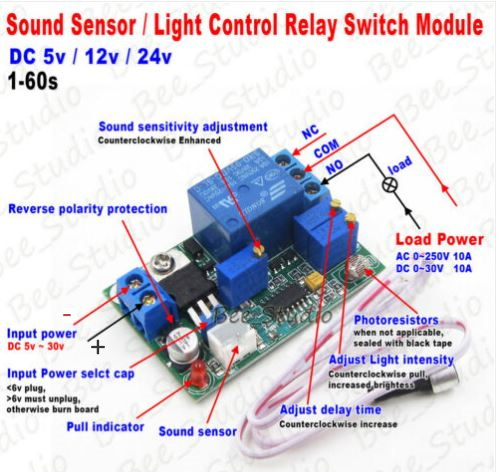
Connected Normally Closed circuit to relay Com and NC contacts and adjusted sensitivity of microphone and time. Microphone is sensitive to claps but in my case it has to be a loud hand clap to trigger it. It has status led that shows when relay is activated so I can see if it is working on my monthly sensor checks.
Looking at my original intentions I am not 100% there as I am relying on single smoke sensor and its speaker. I think I will wait a few years and maybe something will come up that has relay (not relying on internet) but in the meantime I am happy to have something working and have some peace when I am away knowing that something is monitoring it (ordered same relay module for backup).
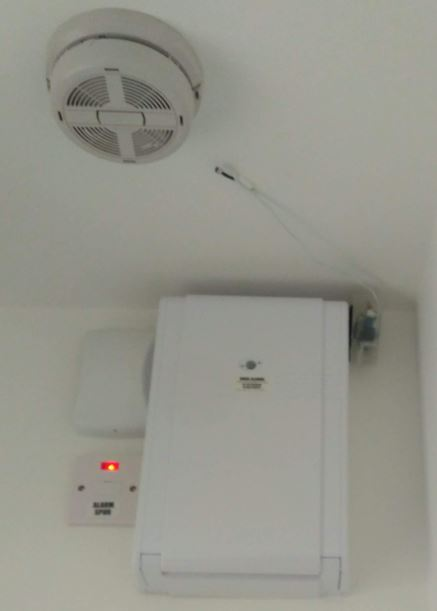
Have a good weekend
-
Connecting smoke detectors to house alarm@NeverDie
Please note that below is just my simple view on sensors of any type.
I think any sensor exposed to environment will need some type or form of maintenance/cleaning or replacement. I also do not think that sensor can test itself unless there is other sensor of different type/technology monitoring other sensor.
As you mentioned previously true way to test sensors is using smoke can from time to time as dust particles/moisture/grease may affect sensors of different types. -
Connecting smoke detectors to house alarm@NeverDie
False alarm is a big annoyance and people start to ignore it/not take it seriously. I was lucky or just strange coincidence that no neighbors reported to me when nobody was in the house and windows were closed (no draft) even with ionization smoke sensors. So based on my personal experience I do not expect too many false alarms when away from the house but i do expect them when i am around be it wife with hairdryer triggering it or steam from bathroom or shower (on rare occasions).
It is hard to choose modes when you think of fire in confined space and time you will be alerted to either extinguish it or run away so if nest notifies at the same sensitivity as ionization sensors then I think it is good balance but it all depends on how fast someone will see/act on it.
Lets hope none of us will have sensors triggered by fire or fail to notify us of fire. -
Connecting smoke detectors to house alarm@NeverDie
Wow, lots of interesting information. It took me more than a day to process it.
My requirements/needs are a bit different and majority of the proposed solutions do not apply in my case but thank you for your time and effort sharing them with me:- Do not want to rely on internet connectivity or AC power. I already have alarm that can send text without internet being live or electricity being present, it is a service i pay yearly for and i had to buy mobile add-on card. So ring and nest do not apply.
- Thanks to your advice I looked at house regulations and my house has to have wired interconnected smoke sensors, so wireless sensor is not an option for me.
- I think arduino project is too complex for my abilities and needs as I only want to operate a relay to break the circuit when high volume is heard. But i do think filter of some type for microphone may be needed to be included to prevent false triggers with low frequency noise.
My plan for now is
- I couldn't find a listener with relay, majority are wireless and for specific alarm panel, will look more into it.
- Test the sound/light relay switch, if it arrives
- If not successful try arduino alarm listening project
- If not successful change my requirements and look for other solutions.
I think of programming as a layer on top of hardware and every single layer on top of hardware is just another layer where the error may occur. So because of that It is nice to have more functionality with smart devices but they should be separated, this is just my personal view on things and that is why I wouldn't like to go for nest unless somebody with knowledge in electronics does a review and says that they are independent devices inside. But on the other hand there are many functionalities that may outweigh single broken sensor failure.
-
Connecting smoke detectors to house alarm@NeverDie
That is unfortunate. Lets wait and see. -
Connecting smoke detectors to house alarm@NeverDie
Everything is now being driven by batteries, unfortunately lithium batteries is just another thing that can create fire, that is just my association with lithium batteries after watching too many liveleak videos.
I think the X-Sense comes with "3 V CR123A lithium battery" and they say should last for 5 years. Below is example of worst case scenario and doesn't look too bad compared to phone batteries.
https://www.youtube.com/watch?v=fG_UuPmLO1c
Having smoke detector on battery for 5-10 years is good way of doing it as it allows you to place sensor anywhere you want and not to depend on AC wiring.
The only thing to check if it is possible to link more than 1 remote control, 1 for each floor/location. Possibly as you would need to get to remote first before going to check originating sensor.
According to below website it is best to use a combination of ionization and photoelectric sensors but not sure if any have 2, I looked on a few and only photoelectric was listed.
https://www.nfpa.org/Public-Education/Staying-safe/Safety-equipment/Smoke-alarms/Ionization-vs-photoelectric
X-sense also has smart wifi smoke detector, I assume it still operates internally between other smoke sensors over RF 868 or 915MHZ and uses 2.4GHZ wifi network and internet connection to get to their servers and notify you on the phone. If it would depend on wifi alone power loss to Access Point would cause communication breakdown between the sensors.
Let me know which one you will go for and your findings. -
Connecting smoke detectors to house alarm@NeverDie
That is very disappointing and very good that you didn't buy it. Why did they even add this feature, additional setup step with no advantage.
So wireless is better option than wired but if you have wires in your house interlinking the units why not use them, wired connection is more reliable than wireless, at least it used to be back in the days with wifi networks. But i am not an engineer and there could be some reasons why they did it. -
Connecting smoke detectors to house alarm@NeverDie
Could it be that person on amazon didn't sync/link all devices together as part of the setup process? One step is to define the zone but the other is to link them together as per video on their website start at 1:16
https://youtu.be/7jun46ZaSmkThank you for finding adapters, I will have it documented in case one sensor goes down and not wanting to replace all BRK sensors.
-
Connecting smoke detectors to house alarm@NeverDie
Thank you for your information about First alert. I looked online and they are selling off their stock in Europe and not manufacturing anything new. Also I didn't find one that is smoke detector only, only a mix of co and smoke detectors. I think i will have to wait and replace all of them when it is time but in the mean time I just would like to setup notification through sound detect circuit. I ordered one to try from china but it will take a while, many items I ordered previously haven't arrived so fingers crossed.I think manufacturers focus only on having alarm panel that they report to in enterprise and think that house owners do not mind checking all sensors.
I read a bit on "First Alert SA511CN2-3ST Interconnected Wireless Smoke Alarm with Voice & Location" and they list within features "When one detector sounds, the other alarms sound as well, alerting you to a fire in the basement even if you are in the attic."
Most likely all sirens beep and sound out of sync so it is a matter of distance between sensors and playback volume of the location. I saw one old video on youtube about setting up one and defining zone of the sensor, they do not play siren noise and voice of location at the same time, 3 beeps, pause, 3 beeps and zone location.
I was reading on some forums in the past that frequent false alarms are caused by bad location and/or wrong sensor type. -
Connecting smoke detectors to house alarm@NeverDie said in Connecting smoke detectors to house alarm:
If I'm not mistaken, an LED on the smoke alarm will illuminate when there is an alarm event. Perhaps you could just glue a photodetector over it to detect when an alarm event occurs? In essence, you'd be making a kind of optoisolator, but without making any changes to any of the smoke alarm elecctronics.
I think it is not achievable due to 2 leds side by side and their behavior. Green is on when AC is live and Red one flashes once every 45 seconds when all is ok and constantly flashes when it is the sensor that triggered sirens very fast and if i remember correctly others flash slower like once a second.
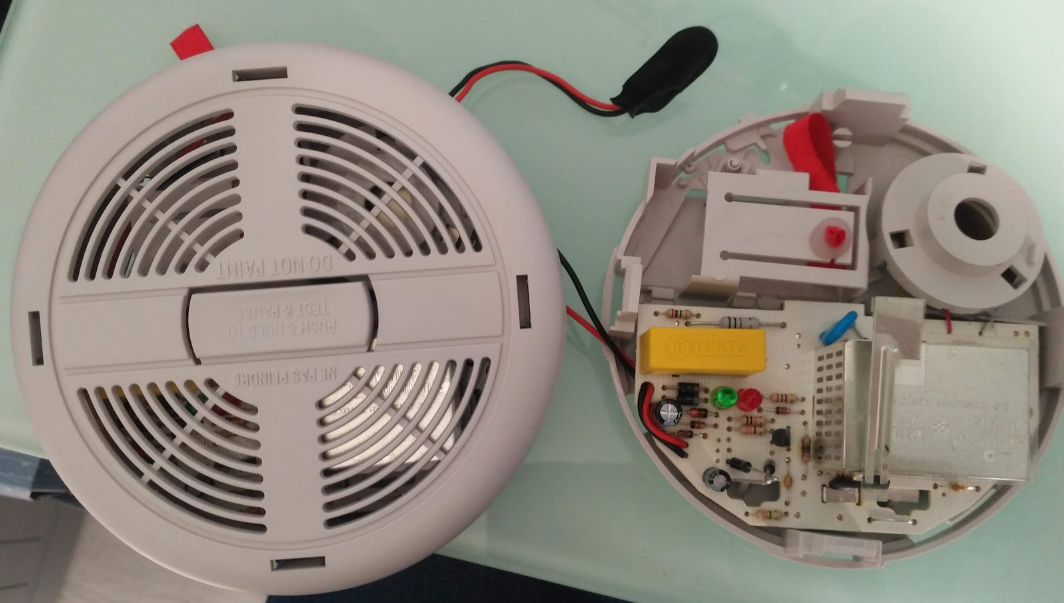
I think trying sound detector would be best as it is placed in utility room where doors are normally closed and it is in the center of the house so no external noise should trigger it (apart from fans on poe switch) if i set it correctly. Just need to order one and wait for it to arrive. Do you think below would be suitable for me, I would just extend microphone cable?
https://www.ebay.ie/itm/122050147713?_trkparms=ispr%3D1&hash=item1c6ac17581:g:e2QAAOSwFfhXjeFN&amdata=enc%3AAQAGAAACoPYe5NmHp%252B2JMhMi7yxGiTJkPrKr5t53CooMSQt2orsSxXDXcCydCuSj2Tq2S%252F3GnlFoJ%252F%252Fg4j6zPtqbaczZyjxYp6hnurvYmPrjeWDDx9Hj6YC7SEXHV9Y3yT0WWwQ3Kcc8Ak79fTVrvlzB4r5TStd6WfP6r5HYdmzKyo49hRC49lv5vpBpNC7TkTpyE8jbQivSkO3T85XUBnAQOBoTRC7tkLe8So%252BQoL0pS7W5SP6geJL%252FlaY0g6qIAhD76dHnnU%252BlIqQM%252FYXr4Wrsqvf4y6Y8fFMpBMqItyDAQj8nYRpAQsndywQZgHO1v30u%252FG1WU7F2Mmv0D%252FqDb84U%252BKNe1VPNpTL6QJP6ioD1z%252FQjnlo4C%252BdRWai66H140EkemOQ39qelshu01nHodtanaT1Ig7as39NbxZqFs9JuDIeghLNMv11L0oOXGnfGtoJEZoNMQ9EYt0L8TGQOas4ZvOUY2Ce94WnXUKoM5NcWkrc%252B89l1Z%252Fll6Gnzl3ms%252FDqwXfIXQzf93IPHW4NmUpzv6OdFoL4UQ%252FefjUzmW7Wg3o2QvGWiOJJ6MVIlF7u3h9jm1FEfRThZjL4BhfCRKK6NRFMwVvHsNhHod5TO382s1biOIVhPyGaLToToGUDebTMSBriCJ%252FuT6Qa%252FmkZY5O1FgmWrQJneypF2I3k6GARyXVaCWwAQK4ff%252FQPFRtvdfwOMcdE5JJUDxGoDDFxvdH%252B59KZ3CtVugsx9LzNW3ec55gxOK2lkkyz23G7EtVzNv%252BJpAawhoZTRpqr17A71Q9UBZOQ7utVUKI2ba%252F4OlXzNb0ej0GXp3Iuh%252FUh2zFSxt355ekfmqu7Ahb8FPJmMhT%252FrIsAZYlZ4h29y7Gs11KvhI6PSu9eaD%252FtPLTF2NPX6NNx2dEZhHQ%253D%253D|ampid%3APL_CLK|clp%3A2334524 -
Connecting smoke detectors to house alarm@NeverDie
Thank you for your time and all the help with this.
I was actually thinking of using some type of relay with microphone after sending my reply yesterday but due to smoke detector location in the room with UPS and NAS that can beep it could create more false positives so need to disable those.I just used 2 spare smoke detectors recently due to failures and thought to buy a few extra just in case but no more for sale anywhere in europe. I started looking for new types but majority are going for RF interlink capabilities or provide RF Gateway and no simple way to trigger/interlink with house alarm.
So microphone /sound triggered relay circuit is my only option, size is not a problem as I can place it on the top of alarm panel and power it from it just microphone cable will have to be ~1 meter to reach smoke sensor but i would prefer to leave the board with microphone on top of the panel and adjust sound levels, just not sure how effective that will be.
https://www.aliexpress.com/item/4001010170294.html?spm=a2g0o.productlist.0.0.398e1225nICgnl&algo_pvid=493ca447-0a34-4eda-a77d-dd8a8f529791&algo_exp_id=493ca447-0a34-4eda-a77d-dd8a8f529791-2https://quasarelectronics.co.uk/Item/cebek-pm-14-vox-controlled-relay-switch-module-with-microphone
Would you advice on adding a fuse between house alarm panel + power aux output and this board, like 100mA to prevent any damage to house alarm panel?Another option would be to install a microphone and connect it to my NAS and use some docker to monitor the sound levels and send email. The problem with this approach is time that email clients on mobile phone check for emails and if no internet connection no notification whereas my house alarm panel uses gsm network to delivery messages.
-
Connecting smoke detectors to house alarm@NeverDie
Thank you for your insight into this.
If you feel that I shouldn't proceed with this please let me know. I just hate going away and not knowing if any of smoke detectors are set off due to fire or annoying neighbors if sensor is faulty. I can check cameras remotely or ask people close by to check.
I think one voltage detection chip is enough as I am testing smoke sensors on monthly basis (ac input and interconnect functionality) so may as well set alarm while doing one and see if it gets triggered. If it triggers house alarm during power outage it is not a problem as i can disarm/disable zone remotely if false alarm.
I have disassembled one unit that I had laying around that was causing problems with false alarm previously and tested voltage between red and black wires connecting to siren while it was running of 9v battery and pressing test button. Voltage was jumping and the highest my multimeter showed was 4.6v DC, i cut one wire and connected multimeter in line in order to measure DC current but it wouldn't show me anything not sure if i didn't set it properly or current is just so small. Also when i was measuring voltage siren volume was 80% quieter if that makes any sense.I think Edward Cheung was using opto-isolator circuit with normally open zone/circuit but i need to use it with normally closed zone/circuit. So not sure how to proceed with this.
-
Connecting smoke detectors to house alarm@NeverDie
Thank you for your suggestion, i have one smoke detector just next to alarm panel so may just as well use it for this purpose, providing voltage detect circuit just disables siren and not affect sensor itself. If I do it this way I will rely on functioning interconnect wire to hear alarm detected by that sensor through sirens of other sensors close by. Something to be aware off but as you suggested adding another one just for this purpose would be a more reliable way.
I will test voltage used across the siren and how accessible connections are in coming days and update the post. Is there a ready made voltage detect circuit that could break 5v dc circuit of house alarm zone, i assume it will depend on voltage and current over siren?
Thank you for helping me with this! -
Connecting smoke detectors to house alarmThank you for your suggestions, please see my comments below.
@NeverDie said in Connecting smoke detectors to house alarm:In the United States BRK makes a relay that, if installed, is triggered when the hardwired 120v BRK smoke detectors start to alarm: https://www.brkelectronics.com/product/RM4
Because it comes with instructions, it takes the guesswork out of it. This allows one to simply connect the relay's dry contacts to your home alarm, if that's your objective. Not sure whether BRK makes anything equivalent for the European or 240v market. Maybe contact BRK to inquire?I have contacted BRK a few months ago and they are going away from European market and advised that there is no relay for 240v. I was reading about this relay before and it only operates if there is AC power available.
I don't recall whether this solution would work if there's no AC power during a fire though. The interconnected alarms should still all sound from their built-in battery backup power, but I'm doubtful the relay would energize during an alarm if the AC had failed for some reason. If that would be a problem, you might have to consider some other solution.
I would prefer not to rely on AC but if not possible, working on AC is better than not having any notification as power outages are rare here.
At least on the fact of it, the Edward Cheung solution that you linked to sounds like a good idea. What's harder to evaluate is whether it can be considered truly fault tolerant or not. You certainly wouldn't want it failing for any reason either before or during an alarm event or to in any way (including all possible failure modes) interfere with the proper operation of the interconnected smoke alarms.
Good luck!
Thank you! I thought i will be able to use some type of relay and be done but not sure if i can operate 120v realy with 240 volt. I will not be powering anything with relay just nead to break the circuit.
-
Connecting smoke detectors to house alarmThank you for your reply, please see my comments below.
@alexelite said in Connecting smoke detectors to house alarm:
@vecnar so you have a smoke sensor with a normally open relay contact, and the contact closes when smoke detection is triggered. As I understand the contact is dry ( potential free).
Smoke sensors have an interconnect wire that is used to communicate with other sensors (no voltage on it during normal operation), it uses itself and negative ac wire. There is 9 volt dc only when there is alarm (between interconnect wire and negative ac wire). So i assume what you wrote is correct.
Your alarm system requires normally closed circuit and triggers on open circuit. (ignoring the resistor and tamper for now).
Correct. I will use zone only for this purpose and it will only operate when alarm is set. I will not need any resistors or tamper on this zone.
You what to connect the two together, no mysensors stuff in between.
Correct, just some type of relay/board that wouldn't rely on ac power as both smoke sensors and alarm have battery backup, smoke sensors 9v DC and alarm has 12v DC.
Did I understand correctly?
Yes. Just not sure if i correctly answered your first question regarding dry contact.
I am trying to achieve the same thing as Edward Cheung the only difference is my alarm zone is normally closed where his is normally opened and not exactly sure about zone current that can be used from alarm panel, below is a spec sheet of my house alarm.
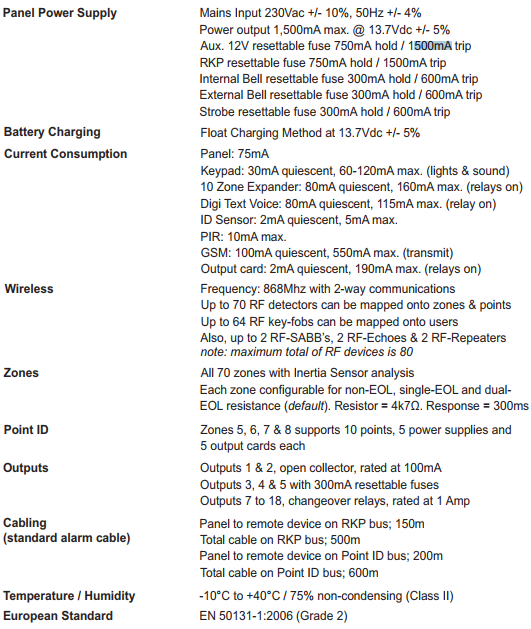
-
Connecting smoke detectors to house alarmHello,
I have posted below reply to https://forum.mysensors.org/topic/1686/video-how-to-monitor-your-smoke-carbon-monoxide-alarm but never got a response so hoping somebody can help me with this.
First of all I am a basic diy person so not much experience with electronics other than basic relays, some soldering and basic use of multi-meter.
I have a brk smoke detectors throughout house and would like to trigger house alarm as it is connected to service that notifies me over the phone. I have looked online for information and stumbled on your video that looked similar to my needs but more so with Edward Cheung. Please advise where best to post this message as I think it may not be appropriate on mysensors.org.
Initially I was thinking of using brk relay but it is rated for 120V AC, I am based in europe with 240V AC, I do not need to power anything with AC and I want it to work when the power is down as both smoke detectors and house alarm operate on batteries.
I purchased the breadboard, 1k and 330 ohm resistors and 2 x PC817 4pin optocouplers without checking if my alarm is supporting normally open zones, it has normally closed options 4k7 resistor end of line and 2k2 resistor end of line and basic normally closed (breaking the circuit triggers alarm).
Alarm zone is a 5 v DC circuit.
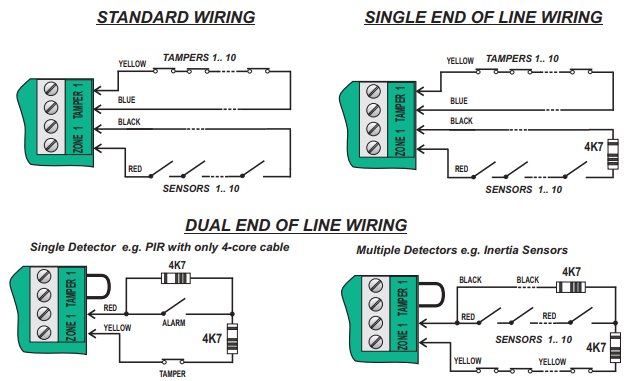
Question:
Any advice on how to get output pins to stay constantly closed and change state when alarm is triggered, should I buy some other optocoupler with 6 pins that has ability to change output contacts when energized or any other approach?
Thank you,
Oleg -
Video How To - Monitor your Smoke/Carbon Monoxide AlarmHello,
First of all I am a basic diy person so not much experience with electronics other than basic relays, some soldering and basic use of multi-meter.
I have a brk smoke detectors throughout house and would like to trigger house alarm as it is connected to service that notifies me over the phone. I have looked online for information and stumbled on your video that looked similar to my needs but more so with Edward Cheung. Please advise where best to post this message as I think it may not be appropriate on mysensors.org.
Initially I was thinking of using brk relay but it is rated for 120V AC, I am based in europe with 240V AC, I do not need to power anything with AC and I want it to work when the power is down as both smoke detectors and house alarm operate on batteries.
I purchased the breadboard, 1k and 330 ohm resistors and 2 x PC817 4pin optocouplers without checking if my alarm is supporting normally open zones, it has normally closed options 4k7 resistor end of line and 2k2 resistor end of line and basic normally closed (breaking the circuit triggers alarm).
Alarm zone is a 5 v DC circuit.
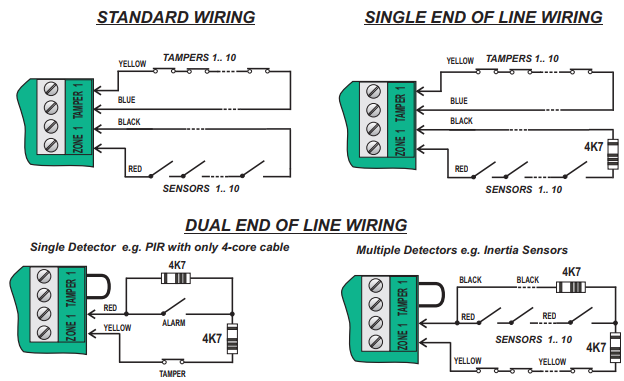
Question:
Any advice on how to get output pins to stay constantly closed and change state when alarm is triggered, should I buy some other optocoupler with 6 pins that has ability to change output contacts when energized or any other approach?Thank you,
Oleg
